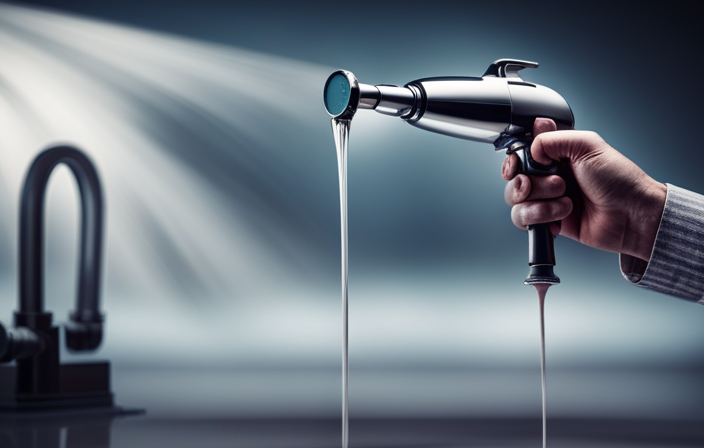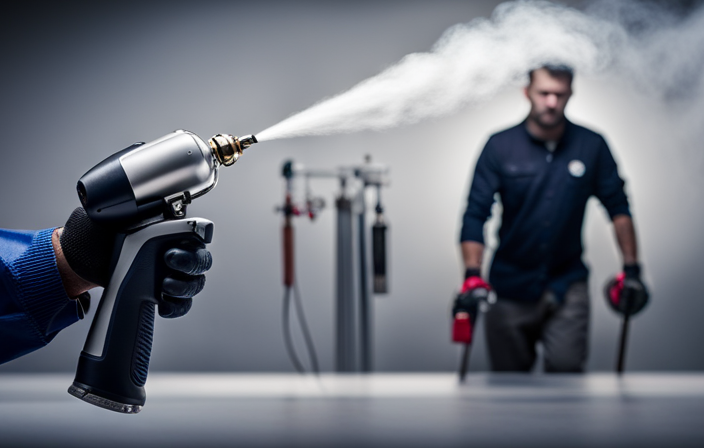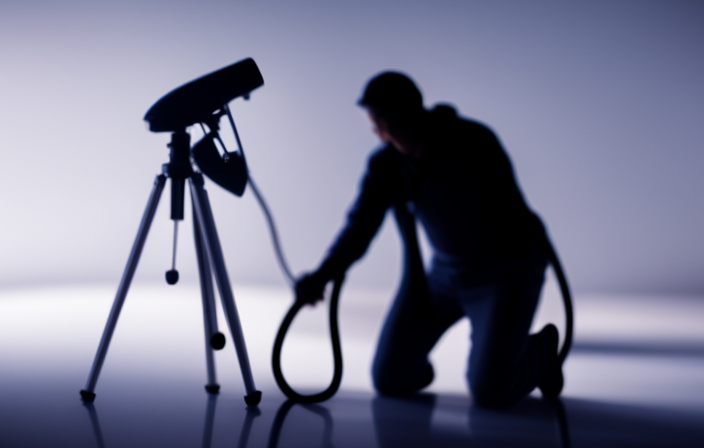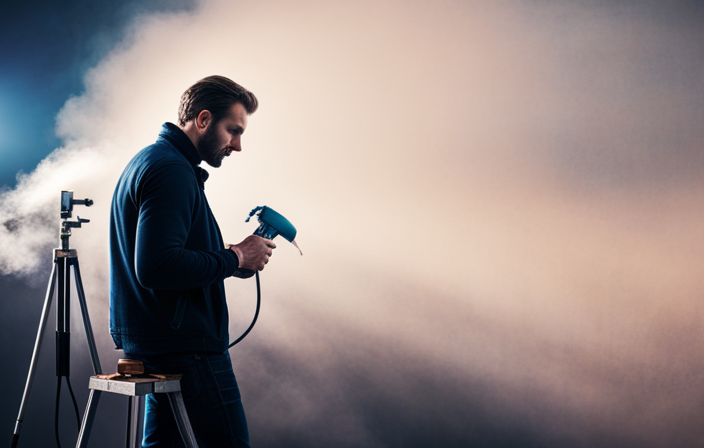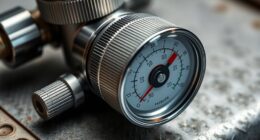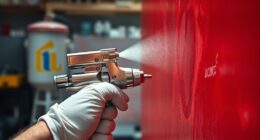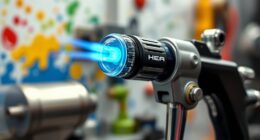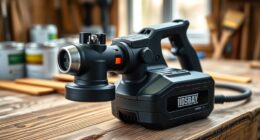Hello! I noticed that you may be struggling with runs when using your airless paint sprayer. Don’t worry, assistance is coming your way. In the following article, I will offer expert advice on how to get rid of those runs and achieve a flawless, smooth finish.
Now, let’s dive into the causes of runs and why they happen in the first place.
I’ll show you how to properly prepare the surface, adjust the sprayer settings for optimal results, and apply thin coats to avoid any drips or sags.
We’ll also talk about using a paint conditioner or flow improver, practicing on a test surface, and giving your paint enough drying time.
Oh, and let’s not forget about the importance of cleaning and maintaining your airless paint sprayer. Trust me, it’ll make a world of difference in preventing those pesky runs.
So, let’s get started and say goodbye to those unwanted paint mishaps once and for all!
Key Takeaways
- Apply thin, even coats of paint to prevent runs
- Clean and prepare the surface properly before painting
- Adjust the sprayer settings and use the correct nozzle size
- Regularly inspect and clean the spray tip to prevent clogs and maintain a consistent spray pattern
Understand the Causes of Runs
So, before we dive into how to fix those pesky runs from your airless paint sprayer, let’s take a moment to understand what causes them.
Paint runs occur when the paint is applied too thickly, gravity pulls it downward, and it starts to drip or sag. Another cause is using the wrong nozzle size, which can result in uneven paint distribution and runs.
To prevent paint runs, make sure to thin the paint if necessary and apply it in thin, even coats. It’s also important to maintain the correct distance between the sprayer and the surface, usually around 12 to 18 inches. Finally, keep the sprayer moving in a consistent motion to avoid overloading any one area.
Now that we know the causes, let’s move on to preparing the surface properly.
Prepare the Surface Properly
Before using an airless paint sprayer, it’s crucial to properly prepare the surface. Here’s how I do it:
- Clean the surface thoroughly and remove any dirt, dust, or grease.
- Carefully inspect for any cracks or imperfections and fill them in with an appropriate filler or putty.
- If necessary, apply a primer to create a smooth and even surface for the paint to adhere to.
Following these steps ensures a professional-looking paint job without any runs or imperfections.
Clean and smooth the surface
To achieve a flawless finish, you’ll want to make sure the surface is impeccably clean and velvety smooth. A smooth surface is essential for the paint to adhere properly and avoid any imperfections. Here are three key steps to clean and smooth the surface:
-
Begin by thoroughly cleaning the surface using a mild detergent and water. This will remove any dirt, grease, or debris that could affect the paint application.
-
Next, sand the surface using fine-grit sandpaper to create a smooth texture. Be sure to sand in the direction of the grain for the best results.
-
After sanding, wipe down the surface with a tack cloth to remove any dust or residue, ensuring a clean and smooth surface for painting.
Once you have achieved a smooth surface, you can move on to the next step of the process, which is using a primer if necessary. By applying a primer, you can further enhance the adhesion of the paint and prevent any potential issues such as peeling or cracking.
Use a primer if necessary
Applying a primer is a must for achieving a flawless finish. It creates a smooth surface, allowing paint to adhere better and preventing runs or streaks. If you don’t have a primer, you can try mixing paint with water to create a thin layer or use a high-quality paint with built-in priming properties. However, these alternatives may not provide the same coverage and durability.
Troubleshooting tip: If you notice runs or drips after applying the primer, lightly sand the area and reapply a thin coat for a smooth finish.
Moving on, it’s important to fill any cracks or imperfections before applying paint.
Fill any cracks or imperfections
If you want a flawless finish, make sure you fill any cracks or imperfections in the surface before you start painting. Choosing the right filler is crucial to ensure a smooth and even surface. Look for a filler that is compatible with the material you are working with, such as wood filler for wooden surfaces or spackling compound for drywall.
Before applying the filler, clean the area thoroughly and remove any loose debris. Apply the filler evenly using a putty knife, making sure to fill in any gaps or cracks completely. Smooth out the filler using the knife or a sanding block, and allow it to dry completely before proceeding with painting.
By filling these imperfections, you will create a solid foundation for a professional-looking paint job.
Now, let’s move on to adjusting the sprayer settings to ensure an even application.
Adjust the Sprayer Settings
Adjusting the sprayer settings will help you achieve a smooth and flawless paint application, leaving no room for those pesky runs. To ensure optimal results, it is crucial to adjust the pressure and select the correct nozzle for your project. By adjusting the pressure, you can control the flow of paint and reduce the chances of runs. A higher pressure setting will result in a finer mist, while a lower pressure setting will produce a heavier spray. Additionally, selecting the appropriate nozzle size is essential. A larger nozzle is suitable for larger surfaces, while a smaller nozzle is ideal for detailed work.
Let’s take a look at the following table to further understand the relationship between pressure and nozzle selection:
| Pressure Setting | Nozzle Size | Result |
|---|---|---|
| High | Large | Fine |
| Medium | Medium | Balanced |
| Low | Small | Heavy |
By adjusting the sprayer settings accordingly, you can achieve a professional, streak-free finish. Now, let’s move on to the next step and explore how to apply thin coats for an even better outcome.
Apply Thin Coats
To achieve a flawless finish, it’s crucial to go for thin coats when using your sprayer. Applying thin coats ensures proper technique and allows for an even application of paint. When the paint is sprayed on too thickly, it can lead to runs and drips, ruining the smooth appearance of the surface.
To avoid this, start by holding the sprayer about 12 inches away from the surface and apply the paint in a steady, sweeping motion. Move the sprayer smoothly and consistently, overlapping each pass to ensure even coverage.
By applying thin coats, you can prevent runs and achieve a professional-looking finish. Maintaining a consistent spraying technique will be discussed in the next section, which is essential for a seamless paint job.
Maintain a Consistent Spraying Technique
To maintain a consistent spraying technique, I keep the sprayer at a steady distance from the surface I’m painting. This ensures an even application of paint and helps prevent streaks or uneven coverage.
I also make sure to move the sprayer in a smooth and even motion, keeping a steady pace to avoid any drips or runs.
Lastly, I overlap each pass slightly to ensure even coverage, making sure that no areas are missed.
These simple techniques help me achieve a professional-looking finish every time.
Keep the sprayer at a consistent distance from the surface
Maintaining a steady and unvarying distance from the surface is crucial to prevent those pesky runs from appearing when using an airless paint sprayer. Proper spraying technique plays a major role in achieving a flawless finish, and one common mistake that can lead to runs is inconsistent distance.
When the sprayer is too close to the surface, excessive paint will be deposited, causing runs and drips. On the other hand, if the sprayer is too far away, the paint may not adhere properly, resulting in an uneven coat.
To avoid this, it is important to keep the sprayer at a consistent distance, usually around 12 to 18 inches, from the surface. By maintaining this distance throughout the painting process, you can ensure an even application and minimize the risk of runs.
Moving the sprayer in a smooth and even motion further enhances the overall finish, allowing the paint to be evenly distributed.
Move the sprayer in a smooth and even motion
Ensure a flawless finish by smoothly and evenly moving the sprayer, allowing for a professional-looking coat that will leave you feeling accomplished. To achieve this, it is crucial to master a smooth spraying technique that avoids streaks. By maintaining a consistent speed and distance from the surface, you can ensure an even application of paint. To help you visualize the correct motion, refer to the table below:
| Movement | Description |
|---|---|
| Left | Begin each pass by moving the sprayer to the left. |
| Right | Follow the leftward motion with a rightward movement. |
| Up | Move the sprayer upwards, covering the surface evenly. |
| Down | Complete the spraying motion by moving the sprayer downwards. |
By incorporating these smooth and even movements, you can prevent runs and achieve a flawless result. Remember, overlap each pass slightly to ensure even coverage in the subsequent section about ‘overlap each pass slightly to ensure even coverage’.
Overlap each pass slightly to ensure even coverage
Achieving a flawless finish requires a smooth and even motion, so make sure to slightly overlap each pass for consistent and thorough coverage. When using an airless paint sprayer, it is important to master the technique of overlapping to ensure evenness.
As you move the sprayer back and forth, overlap each pass by about 50% to avoid leaving gaps or streaks. This technique ensures that the paint is applied evenly across the surface, preventing runs and drips. By overlapping, you also ensure that every area receives the appropriate amount of paint, resulting in a professional-looking finish.
Smoothly transition into the subsequent section about checking for clogs and cleaning the spray tip, which is crucial for maintaining optimal sprayer performance.
Check for Clogs and Clean the Spray Tip
When using an airless paint sprayer, it’s important to regularly inspect the spray tip for clogs. This can be done by visually checking for any debris or blockage. If there is a clog, it’s recommended to use a cleaning solution or a wire brush to remove the obstruction.
Additionally, it’s crucial to replace the spray tip if it’s worn-out or damaged. This is because a worn-out or damaged spray tip can affect the quality of the spray pattern.
Regularly inspect the spray tip for clogs
Make sure you regularly check the spray tip for any clogs to prevent runs when using an airless paint sprayer. Proper inspection techniques are crucial for maintaining a smooth paint application. By following these troubleshooting tips, you can ensure that your spray tip remains clean and unclogged.
| Column 1 | Column 2 | Column 3 | Column 4 | Column 5 |
|---|---|---|---|---|
| Step 1 | Step 2 | Step 3 | Step 4 | Step 5 |
| Inspect the spray tip visually | Remove the spray tip for a closer inspection | Clean the spray tip using a cleaning solution | Use a wire brush to remove any debris | Check for any remaining clogs by spraying water through the tip |
Regularly inspecting the spray tip for clogs is essential to prevent paint runs and achieve a professional finish. Once you have ensured that the spray tip is free from any obstructions, you can proceed to the next step of using a cleaning solution or a wire brush to remove any debris. This will further ensure that your airless paint sprayer operates at its best capacity and delivers flawless results.
Use a cleaning solution or a wire brush to remove any debris
Using a cleaning solution or a wire brush is an effective way to ensure a smooth paint application by removing any debris from the spray tip.
There are several benefits to using a cleaning solution. Firstly, it is specifically designed to break down dried paint and other stubborn residues, making it easier to remove them from the spray tip.
Secondly, a cleaning solution can help prevent clogs and blockages in the future, ensuring a consistent spray pattern.
As for the wire brush, it is highly effective in removing any loose debris or chunks of paint that may have accumulated on the spray tip. Its bristles can reach into tight spaces and dislodge any stubborn residue.
By using either a cleaning solution or a wire brush, you can keep your airless paint sprayer in optimal condition, ensuring a flawless paint job.
To further maintain the spray tip, it is important to replace it if it is worn-out or damaged, as this can affect the quality of the paint application.
Replace the spray tip if it is worn-out or damaged
If the spray tip is worn-out or damaged, it’s time to replace it to ensure a flawless paint job. Proper spray tip maintenance is essential for achieving optimum performance with your airless paint sprayer.
Over time, spray tips can become worn or damaged due to constant use or buildup of paint residue. When this happens, the spray pattern may become uneven, resulting in runs or streaks on the painted surface.
Troubleshooting spray tip issues is relatively simple. Start by examining the tip for any signs of wear or damage. If you notice any, it’s best to replace it with a new one. This will guarantee that the paint is evenly distributed and eliminate the risk of runs.
Now, let’s move on to the next step and discuss how to use a paint conditioner or flow improver to further enhance your paint job.
Use a Paint Conditioner or Flow Improver
When using an airless paint sprayer, it is important to achieve the right consistency of paint for a smooth and even finish. One way to achieve this is by adding a paint conditioner or flow improver to the paint. By doing so, you can improve the flow of the paint and reduce the likelihood of clogs or runs.
To ensure the best results, it is crucial to mix the paint thoroughly to guarantee a proper consistency. Lastly, it is essential to follow the manufacturer’s instructions for the additive, as different products may have specific guidelines for usage.
Add a paint conditioner or flow improver to the paint
To eliminate runs from an airless paint sprayer, simply add a paint conditioner or flow improver for a smoother finish. This technique is one of the most effective painting techniques when it comes to troubleshooting tips for getting rid of runs.
The paint conditioner or flow improver works by reducing the surface tension of the paint, allowing it to flow evenly and smoothly.
Adding a paint conditioner or flow improver to the paint can be a game-changer. It helps to break up any clumps or lumps in the paint, ensuring a consistent and uniform application. Additionally, it helps to prevent clogs in the sprayer nozzle, allowing for a steady and uninterrupted flow of paint.
Incorporating this step into your painting process will greatly improve the overall quality of your finish.
Now, let’s move on to the next step: mixing the paint thoroughly to ensure proper consistency.
Mix the paint thoroughly to ensure proper consistency
To continue our journey of achieving a flawless paint finish, we have already discussed the importance of adding a paint conditioner or flow improver to the paint. Now, let’s dive into the next step: mixing the paint thoroughly. This crucial step ensures that the paint has the right consistency for an airless paint sprayer.
When it comes to mixing techniques, there are a few options to consider. You can use a paint stir stick or a drill with a mixing attachment to achieve a smooth and homogenous mixture. Remember to scrape the sides and bottom of the paint container to incorporate any settled pigments.
To give you a better understanding, let’s take a look at this table:
| Mixing Techniques | Troubleshooting Tips |
|---|---|
| Use a paint stir stick | If the paint is too thick, add a small amount of water to thin it out |
| Use a drill with a mixing attachment | If the paint is too thin, add more paint to achieve the desired consistency |
Now that we have mastered the art of mixing, let’s move on to the next step: following the manufacturer’s instructions for the additive.
Follow the manufacturer’s instructions for the additive
Before diving into the next step, let’s follow the manufacturer’s instructions for the additive to ensure we’re on the right track. Using the right additive can greatly help in preventing runs from an airless paint sprayer. Here are a few key ideas to keep in mind:
-
Determine the correct ratio: The manufacturer’s instructions will specify the appropriate amount of additive to add to the paint. This is crucial to achieve the desired consistency and prevent runs.
-
Mix the additive thoroughly: Ensure that the additive is well incorporated into the paint by stirring it properly. This will help maintain an even flow and reduce the chances of runs occurring.
Now that we understand the importance of following the manufacturer’s instructions for the additive, let’s move on to the next section about practicing on a test surface.
Practice on a Test Surface
After practicing on a test surface, you’ll see the visual representation of ideas by getting rid of runs from an airless paint sprayer.
Testing your technique on a small, inconspicuous area before tackling the entire surface has numerous benefits.
Firstly, it allows you to familiarize yourself with the sprayer’s settings and adjust them accordingly for optimal results.
Secondly, it helps you determine the right distance to hold the sprayer from the surface to avoid excessive paint buildup.
Additionally, testing different nozzle sizes and spray patterns on the test surface can help you achieve the desired coverage and minimize the risk of runs.
By following these best practices for testing, you can gain confidence and refine your technique, ensuring a flawless finish.
Taking breaks and allowing proper drying time between coats is the next crucial step in achieving a professional-looking paint job.
Take Breaks and Allow Proper Drying Time
To achieve a flawless finish in your painting project, it is crucial to give yourself a break and allow enough time for the paint to dry properly. This will help you avoid runs in your paint job when using an airless paint sprayer. Different types of airless paint sprayers may have varying drying times, so it is essential to follow the manufacturer’s guidelines.
Proper ventilation is also key to ensure that the paint dries evenly and quickly. Adequate airflow helps prevent moisture buildup, which can lead to runs and uneven drying.
Once you have allowed enough time for the paint to dry, you can move on to the next step of cleaning and maintaining your airless paint sprayer. This will ensure its longevity and optimal performance.
Clean and Maintain Your Airless Paint Sprayer
Now that we have discussed the importance of taking breaks and allowing proper drying time, let’s shift our focus to another crucial aspect of getting rid of runs from an airless paint sprayer: cleaning and maintaining the equipment.
Cleaning techniques are essential to ensure the proper functioning of your sprayer and prevent any clogs or buildup that can lead to uneven paint application. Regularly flushing the system with water or a cleaning solution can help remove any residual paint and keep the nozzle clear.
Additionally, troubleshooting tips such as checking the filters, inspecting the seals, and lubricating the moving parts can help address any issues that may arise during the painting process.
By following these cleaning techniques and troubleshooting tips, you can maintain the efficiency and longevity of your airless paint sprayer.
Frequently Asked Questions
Can I use any type of paint with an airless paint sprayer?
Yes, you can use various types of paint with an airless paint sprayer. However, it’s important to consider the pros and cons of each type, such as durability, coverage, and drying time, to ensure the best results for your project.
How do I prevent overspray when using an airless paint sprayer?
To prevent overspray when using an airless paint sprayer, I adjust the pressure on the sprayer according to the manufacturer’s instructions. I also make sure to troubleshoot common issues that may cause overspray.
Can I use an airless paint sprayer to paint textured surfaces?
While airless paint sprayers can be used to paint textured surfaces, it’s important to note that they may not provide the best coverage. Consider alternative painting methods, such as using a roller or brush, for better results on textured surfaces.
What safety precautions should I take when using an airless paint sprayer?
When using an airless paint sprayer, it’s important to prioritize safety. Make sure to wear the appropriate safety equipment, such as goggles and a mask, and work in an area with proper ventilation.
How often should I clean the filters on my airless paint sprayer?
I clean the filters on my airless paint sprayer regularly to ensure optimal performance. It is recommended to clean the filters after every use or at least once a month to prevent clogging and maintain efficiency.
Conclusion
In conclusion, it’s important to address the issue of runs when using an airless paint sprayer. Understanding the causes and taking necessary precautions can greatly minimize their occurrence.
To start, make sure to prepare the surface properly before painting. This includes cleaning and sanding if necessary.
Next, adjust the sprayer settings appropriately. This means choosing the right spray tip size and adjusting the pressure to a level that will provide an even application of paint.
Using a paint conditioner or flow improver can also help to enhance the smoothness of your paint job. These products can be added to the paint before spraying.
Before tackling your actual project, it’s a good idea to practice on a test surface. This will allow you to get a feel for the sprayer and make any necessary adjustments before starting on the actual surface.
Lastly, be sure to allow for proper drying time between coats. This will help to prevent runs and ensure a flawless finish.
In addition to these measures, it’s important to regularly maintain and clean your airless paint sprayer. This will contribute to its longevity and optimal performance.

